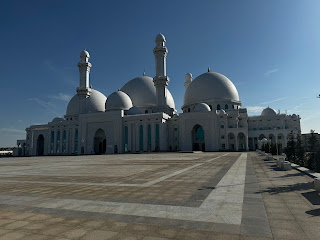Cycling Day 7: Tarar Rysqulov to Shymkent
Shymkent is basically the Texas of Kazakhstan. That is what my host, Nur-Sultan told me when I met up with him in the afternoon after rolling into Shymkent. After a short time here, I can kind of get the gist, that these people are proud southerners - proud of their heritage, culture, religion, history, and even their accents.
The ride was very pleasant. I enjoyed the tree-coverage and rolling hills through Turkistan. Shymkent is a fairly large city of 1.2 million, and the urban sprawl begins about 15 miles outside of the city.
Nur-Sultan is a student at the university in Shymkent and is currently working a summer job doing digital mapping and cartography for a local company. He was eager to show me the city and expose me to more Kazakh culture. He told me about the three Jüz - essentially ruling regional tribes - and how they formed over history into a coalition. The Great Tribe is the ruling tribe, the Middle Tribe (the southern tribe, and Nur-Sultan’s tribe) is comprised of intellectuals and scholars who write and interpret the rules, and the Young Tribe contains the warriors and fighters. In fact, these tribes are so well-established that it is still illegal in Kazakhstan to marry someone from your own tribe, as it is considered incest. The leaders of these three tribes established the national Kazakh identity under the Soviet Union and ultimately led to the creation of Kazakhstan in 1991.
We went to a traditional restaurant in town. This was a beautiful establishment and we ate in a traditional room, sitting on the floor with an elevated table. Nur-Sultan likes traditions and observing customs. He noted while we were eating, that the guest must be higher than the host while at the table, and also showed me how to use the pillows assembled on the floor for back and elbow support.
Our traditional table at the restaurant
Traditional clothing offered at the restaurant for pictures
After lunch, we met up with another couchsurfer, Kuanish, who had messaged me a few days earlier, wanting to meet up with me and show me some sites. Nur-Sultan had some work to do and told us he would meet us later. The morning clouds had cleared and it was very hot. Kuanish and I took a comfortable, air conditioned public bus to the site of the “new city”, which he noted was the government’s attempt at moving the center of activity of Shymkent to a different location. I asked if that was really possible, since Shymkent seems to have an established downtown area. He said the government can control this because they can force people to move into homes. In fact, when a couple gets married in Kazakhstan, they are eligible to apply for a government program in which they will be given a local apartment after some period of time. That would explain a lot of the construction projects I’ve seen as I’ve ridden across the country. Certainly, some apartments are purchased, but in this system, it appears that the government provides a large portion of people’s housing.
Part of the Baidibek Bi monument park
We went to the Baydibek Bi monument, it is the tallest monument in Kazakhstan, located on top of a large staircase and gives a great panoramic view of Shymkent.
In the distance I could see a giant mosque, when reading about Shymkent I had heard about the Akmeshit Mosque, or White Mosque. Kuanish said the Mosque was financed by a local billionaire who owns a lot of businesses. It took 10 years to complete and just opened this past January. He said we could go there, it was appropriate for tourists to go and take pictures and, as a Muslim, he wanted to get one of his prayer movements in for the day.
The new White Mosque of Shymkent
The scale of this Mosque is incredible, it is gigantic. He said the inside can accommodate 30,000 people and the Mosque’s opening drew 100,000 people, who also prayed outside. The decorations inside are beautiful. I went with Kuanish to the restrooms, I figured they would be interesting in such an opulent place. I don’t think I had ever seen a washroom quite like this before. There were no sinks, just taps about 3 feet off the ground with little marble stools. These were for the pre-prayer ablutions. You sit at the stool and wash your hands, elbows, face and feet before going to pray. Soap, paper towels and shower shoes are provided.
The Mosque’s washrooms
The inside of the Mosque’s prayer area is enormous, and completely empty, aside from the Imam’s alter. Kuanish went to perform his prayer movements and I sat at the back and meditated for a bit. Women were conspicuously absent from this area. They have their own areas of the mosque so that they can pray out of sight of the men.
We then took the bus to the river that runs through the city. It is direct mountain runoff, so the water is very clear and very cold. There are merchants all over selling corn on the cob and little kids playing in the water and at the various playgrounds in the area. I relaxed on the grass and did some handstands.
We met back up with Nur-Sultan and had another Kazakh dinner - Plov with Shashlik.
I was completely exhausted after that and went back to Nur-Sultan apartment and promptly fell asleep.
All of these experiences really lent themselves to the Texas comparison of Shymkent, everything is bigger and better in Shymkent.
Our meal of barbecue and plov. This was a half portion and between the three of us, we could not finish it.














Comments
Post a Comment